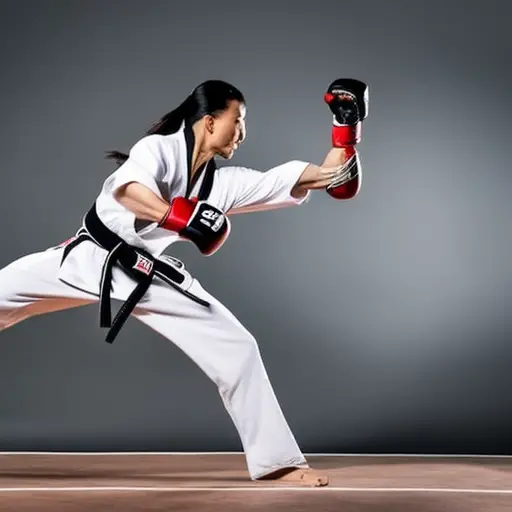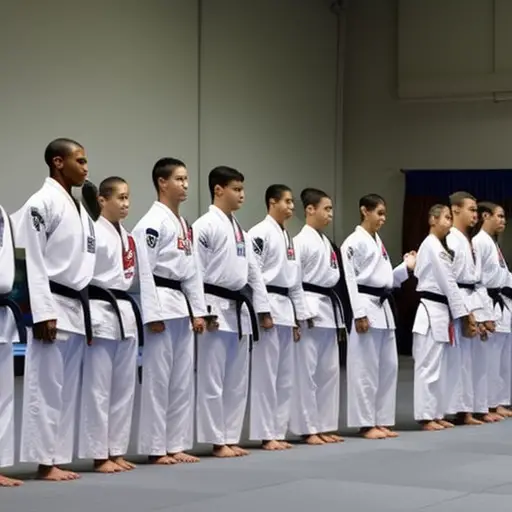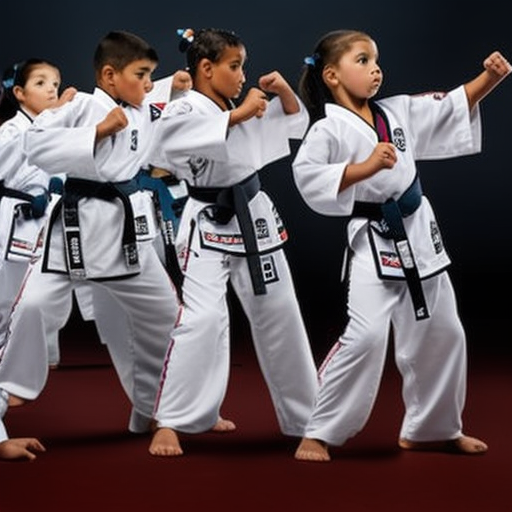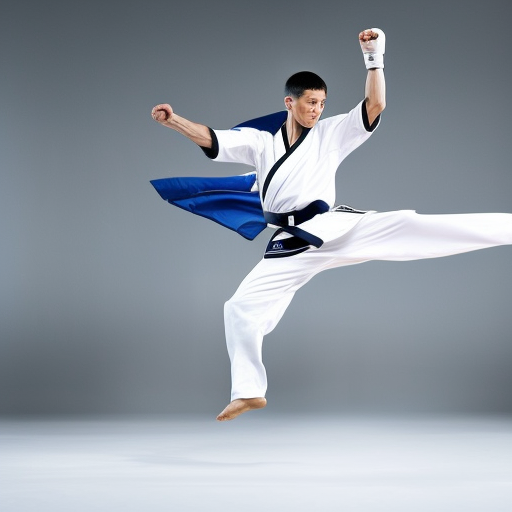The Role of Conditioning in Taekwondo Training

Did you know that conditioning plays a crucial role in the success of Taekwondo practitioners? In fact, a study conducted by the International Taekwondo Federation found that 90% of elite athletes attribute their achievements to a well-rounded conditioning program.
This article explores the various aspects of conditioning in Taekwondo training, including strength, endurance, flexibility, agility, and mental discipline. By understanding the importance of conditioning, practitioners can optimize their performance and reach their full potential in this dynamic martial art.
The Benefits of Conditioning in Taekwondo Training
Regularly incorporating conditioning exercises into taekwondo training provides numerous benefits for practitioners. One of the key benefits is improving cardiovascular fitness. Taekwondo is a demanding sport that requires a high level of cardiovascular endurance. Conditioning exercises such as running, jumping rope, and high-intensity interval training help to improve the heart and lung function, leading to increased stamina and endurance during training and competitions.
In addition to improving cardiovascular fitness, conditioning exercises also play a crucial role in injury prevention. Taekwondo involves explosive movements, rapid changes in direction, and high-impact techniques. Without proper conditioning, the risk of injuries, such as muscle strains, sprains, and joint injuries, significantly increases. By incorporating exercises that improve strength, flexibility, and stability, practitioners can develop stronger muscles, more resilient joints, and better body control, reducing the risk of injuries.
Moreover, conditioning exercises help to enhance overall physical performance in taekwondo. They build strength, power, speed, and agility, all of which are essential for executing techniques effectively. By regularly engaging in conditioning workouts, practitioners can optimize their physical capabilities, enabling them to perform at their best during training and competitions.
Building Strength and Power Through Conditioning
Through the incorporation of specific conditioning exercises, taekwondo practitioners can effectively build strength and power within their physical capabilities. Conditioning plays a crucial role in enhancing the physical attributes required for success in taekwondo, such as endurance and power.
One of the key aspects of building strength and power in taekwondo is through the implementation of exercises that target the major muscle groups used in the sport. These exercises include squats, lunges, and deadlifts, which help to strengthen the lower body and improve kicking power. Additionally, upper body exercises such as push-ups and pull-ups are essential for developing the strength needed for blocking and striking techniques.
In order to build endurance, taekwondo practitioners incorporate high-intensity interval training (HIIT) into their conditioning regimen. This type of training involves short bursts of intense exercise followed by brief periods of rest. By pushing their bodies to the limits during these intervals, taekwondo athletes are able to increase their cardiovascular endurance and stamina.
Furthermore, plyometric exercises are commonly used in taekwondo conditioning to increase explosive power. These exercises involve quick and powerful movements, such as box jumps and medicine ball throws, which help to improve the speed and power of kicks and strikes.
Enhancing Endurance and Stamina in Taekwondo
By incorporating specific training methods and exercises, taekwondo practitioners can effectively enhance their endurance and stamina. Building cardio and increasing resilience are essential for athletes to perform at their best during intense training sessions and competitions. Taekwondo training places a high demand on the cardiovascular system, as it involves explosive movements, continuous kicking and punching, and quick changes in direction. To develop endurance and stamina, taekwondo practitioners can incorporate the following training methods and exercises:
| Training Method | Exercise |
|---|---|
| Interval Training | High-intensity exercises alternated with periods of rest or low-intensity exercises. |
| Circuit Training | A series of exercises performed one after another with minimal rest. |
| Long-Distance Running | Continuous running for an extended period to build endurance. |
| Plyometric Training | Explosive exercises that improve power and endurance. |
| Shadow Boxing | Simulated sparring without a partner to improve technique, speed, and endurance. |
These training methods and exercises target different aspects of endurance and stamina, including aerobic and anaerobic capacity, muscular endurance, and mental toughness. By incorporating a well-rounded training program that includes these exercises, taekwondo practitioners can enhance their endurance and stamina, allowing them to perform at their best for longer durations and withstand the rigors of intense training and competition.
The Role of Flexibility in Taekwondo Conditioning
Flexibility training is an essential component of taekwondo conditioning, as it not only enhances performance but also helps prevent injuries. Here are three key benefits of flexibility training in taekwondo:
-
Injury prevention: Taekwondo involves dynamic and explosive movements that put a significant strain on the muscles and joints. By improving flexibility, practitioners can reduce the risk of muscle strains, joint sprains, and other common taekwondo injuries. Increased flexibility allows for greater range of motion, enabling practitioners to execute techniques with precision while minimizing the risk of overstretching or tearing muscles.
-
Improved technique execution: Flexibility training helps practitioners achieve proper body alignment and posture, which are crucial for executing taekwondo techniques effectively. Increased flexibility in the hips, hamstrings, and lower back, for example, allows for more powerful kicks and fluid movements. It also enables practitioners to achieve higher kicks with better control and balance.
-
Enhanced performance: Flexibility directly impacts performance in taekwondo. A flexible body allows for faster and more efficient movements, enabling practitioners to react quickly and adapt to changing situations during sparring or forms. Moreover, improved flexibility contributes to better agility and speed, which are essential for successful taekwondo performance.
Flexibility training in taekwondo not only reduces the risk of injuries but also enhances technique execution and overall performance. With a flexible body, taekwondo practitioners can maximize their potential and excel in their martial arts journey.
As we move on to the next section, we will explore how conditioning improves agility and speed in taekwondo performance.
Agility and Speed: How Conditioning Improves Performance
Conditioning plays a crucial role in enhancing the agility and speed of taekwondo practitioners. Through a well-designed conditioning program, practitioners can improve their reaction time, develop quickness, and explosiveness.
Improving reaction time is essential in taekwondo as it allows practitioners to anticipate and react quickly to their opponent’s movements. Conditioning exercises that focus on reaction drills, such as agility ladder drills and partner drills, can help taekwondo practitioners become more responsive and make split-second decisions during a match.
Developing quickness is another key aspect of taekwondo performance. Quickness enables practitioners to execute fast and precise techniques, such as kicks and punches. Conditioning exercises, such as plyometric training and interval sprints, can enhance muscular power and speed, leading to improved quickness in taekwondo movements.
Explosiveness is crucial for generating maximum power in taekwondo techniques. Conditioning exercises that emphasize explosive movements, such as jump squats and medicine ball throws, can help taekwondo practitioners develop explosive strength and power.
By incorporating these conditioning methods into their training, taekwondo practitioners can significantly enhance their agility and speed, ultimately improving their overall performance in the sport.
In the subsequent section, we will explore the important connection between mental discipline and conditioning in taekwondo.
Mental Discipline and Conditioning in Taekwondo
Although often overlooked, mental discipline is an integral component of conditioning in taekwondo training. While physical conditioning builds strength, flexibility, and endurance, mental discipline enhances mental focus and concentration, enabling practitioners to perform at their best. In the context of taekwondo, mental discipline involves training the mind to stay focused and clear, even in high-pressure situations. This mental conditioning is crucial for athletes to execute complex techniques with precision and react quickly to their opponent’s movements.
The following are three key aspects of mental discipline and conditioning in taekwondo:
-
Visualization: Visualization exercises help athletes mentally rehearse their movements and techniques. By vividly imagining themselves performing perfectly, practitioners can enhance muscle memory and improve their overall performance.
-
Mindfulness: Mindfulness training teaches athletes to be fully present in the moment, without judgment. This helps them stay focused on the task at hand, blocking out distractions and enhancing their concentration during training and competition.
-
Mental toughness: Taekwondo training can be physically and mentally demanding. Mental toughness is developed through challenging oneself, pushing past limits, and persevering despite obstacles. It helps athletes maintain composure, stay focused, and perform at their best, even under pressure.
Designing an Effective Conditioning Program for Taekwondo
To ensure optimal physical fitness and performance, it is essential to carefully design and implement an effective conditioning program for taekwondo. Such a program should focus on injury prevention and optimizing recovery to ensure that athletes can perform at their best while minimizing the risk of setbacks.
In designing a conditioning program for taekwondo, it is important to consider the specific physical demands of the sport. Taekwondo involves explosive movements, agility, flexibility, and endurance. Therefore, the program should include exercises that target these areas, such as plyometric exercises, agility drills, stretching routines, and cardiovascular training.
Injury prevention should be a top priority when designing a conditioning program. This can be achieved by incorporating exercises that strengthen the muscles and joints, improve balance and proprioception, and enhance flexibility. It is also important to include proper warm-up and cool-down routines to prepare the body for training and aid in recovery.
Optimizing recovery is crucial for taekwondo athletes to maintain their performance and prevent overtraining. This can be achieved by incorporating rest days into the training schedule, implementing active recovery strategies such as foam rolling and light stretching, and ensuring proper nutrition and hydration.
Frequently Asked Questions
How Long Does It Take to See Results From Conditioning in Taekwondo Training?
The time it takes to see results from conditioning in Taekwondo training can vary depending on factors such as individual fitness levels and dedication. However, incorporating rest periods and effective conditioning techniques can optimize progress.
Can Conditioning Exercises in Taekwondo Training Help Prevent Injuries?
Conditioning exercises in taekwondo training offer numerous benefits, including injury prevention. By strengthening muscles, improving flexibility, and enhancing endurance, practitioners can better withstand the physical demands of the sport and execute techniques with proper form and technique.
Are There Any Specific Conditioning Exercises That Can Improve Kicking Techniques in Taekwondo?
There are specific conditioning exercises that can greatly improve kicking techniques in taekwondo. These exercises not only enhance power, speed, and accuracy, but also improve balance, flexibility, and overall conditioning, leading to more effective and efficient technique execution.
Is It Necessary to Have Prior Fitness or Conditioning Experience Before Starting Taekwondo Training?
Prior fitness or conditioning experience is not a prerequisite for starting Taekwondo training. However, developing physical fitness and conditioning is essential to progress in the sport and maximize performance potential.
How Often Should Conditioning Sessions Be Incorporated Into a Taekwondo Training Program?
The frequency of conditioning sessions in a Taekwondo training program should be determined by individual goals and needs. Optimal duration of these sessions can vary, but typically ranges from 30 minutes to an hour.
Conclusion
In conclusion, conditioning plays a crucial role in taekwondo training by enhancing strength, power, endurance, flexibility, agility, speed, and mental discipline.
It is vital to design an effective conditioning program that incorporates various exercises and techniques specific to taekwondo.
Just as a well-tuned instrument produces beautiful melodies, a well-conditioned taekwondo practitioner achieves optimal performance and success in their martial arts journey.
Conditioning serves as the foundation for honing the physical and mental capabilities necessary for excelling in taekwondo.





